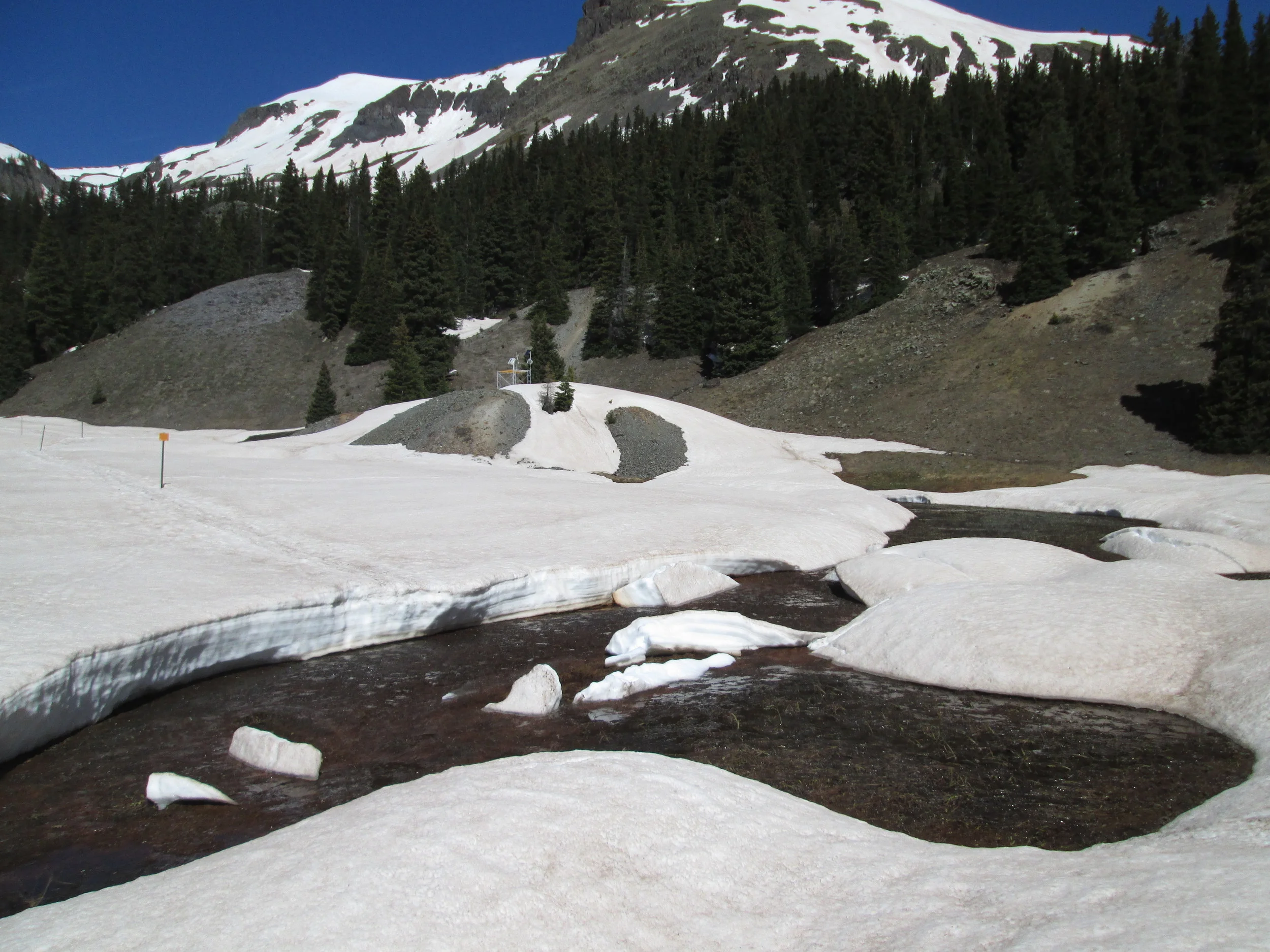DUST-ON-SNOW IMPACTS ON COLORADO HYDROGRAPHS 2006-2021
In our WY 2016 Summary report, and in presentations during Fall 2015, we introduced a refined approach to understanding the impacts of dust-on-snow on Colorado snowmelt runoff ‘patterns’, as reflected in headwater hydrographs. CODOS has observed dust conditions and snowmelt behaviors in Colorado since 2006. It has become apparent, in that period, that the interactions of three primary factors – March 1 SWE, spring dust intensity, and spring weather (precipitation) – comprise a “dust enhanced snowmelt runoff space” (Figure 1). First and foremost among those factors, snowcover water content (i.e., snow water equivalence, or SWE) in Colorado watersheds dictates snowmelt runoff yields and a basin hydrograph’s overall magnitude. March 1 SWE conditions offer a meaningful benchmark in seasonal snowpack formation that also coincides with the onset of ‘dust season’, as 80% of the dust-on-snow events observed by CODOS since 2005 have occurred in March, April and May.
Then, although the presence of dark mineral dust at or near the snowcover surface during daytime always accelerates snowmelt rates by reducing snow albedo and increasing absorption of solar radiation, dust-on-snow does not automatically result in an early runoff cycle. Considerable variation in the overall timing and rates of snowmelt from equivalent snowpacks containing equivalent dust can occur as a result of differences in the number and size of March, April, and May snowfalls. A dry spring, with fewer and smaller spring snowfalls, prolongs dust layer exposure and maximizes dust impacts on snowmelt. A wet spring with frequent, large spring snowfalls results in repeatedly burying exposed dust and restoring high snow albedo, delaying the full impact of dust until a later period of prolonged dust emergence. Hence, besides contributing additional snow to the seasonal total, March, April and May precipitation plays a key role in determining the timing and rate of dust-enhanced snowmelt runoff, from a given snowpack containing dust.
CODOS has now observed twelve seasons of dust-enhanced snowmelt runoff behavior throughout the Colorado mountains (WY 2006-2021). Hydrographs at headwater stream gauges have been evaluated and classified within the framework of this dust enhanced snowmelt runoff space utilizing a 3 x 3 x 3 cell matrix corresponding to general characterizations of SWE, dust intensity, and spring weather, as shown in Figure 1.
Figure 1: a conceptual dust enhanced snowmelt runoff model integrating the interactions of March 1 SWE, dust intensity, and spring precipitation.
In this approach, March 1 SWE classifications are based on NRCS 1981-2010 statistics for Snotel stations proximal to the eleven sites monitored by CODOS. “Average SWE” is defined as a Snotel site’s 1981-2010 median value for March 1, +/- 10%. Values outside that 90-110% of median condition are classified as either High or Low March 1 SWE.
Dust intensity classification is based on dust conditions observed since 2005 at CSAS’s Senator Beck Basin Study Area (SBB). Dust intensity characterization at SBB represents a difficult challenge since dust deposition intensity has, overall, increased during the period of CODOS observations. As such, the notion of “average” dust intensity has changed over that period and may not yet have stabilized. During the past four seasons, in collaboration with USGS, CODOS has collected and analyzed dust mass loading samples and quantified dust loading at SBB. Those measurements have enabled calibration, from snowpit observations and photographs, of prior seasons at SBB using this three-part classification scheme.
Although still a short period of record, during a period of rapidly changing conditions, these characterizations may be sufficient to distinguish one season from another in this tree-part classification scheme. Within this period of record (2006-2021) Water Year 2007 is classified as “Min+” dust intensity and WY 2006 and WY 2010 are considered “Max-“. (Prior WY’s 2004 and 2005 might also be classified as “Min” dust seasons at SBB, relative to subsequent years, but are not included in these analyses due to incomplete observations.) It is further understood that dust intensity at SBB is typically stronger than observed at sites farther downwind, to the north and east. (CODOS resources have not enabled the collection of dust mass loading samples comparable in quality and frequency to those collected at SBB.) Dust intensity characterizations at sites beyond SBB are, in this classification, both tied to “Min”, “Avg”, and “Max” conditions at SBB as well as being site specific and relative to observed “all layers merged” intensity near the end of the season at the given site (i.e., of generally lower ‘absolute’ intensity than SBB).
Spring precipitation classifications are also based on NRCS 1981-2010 statistics for Snotel stations proximal to the eleven sites monitored by CODOS. Average precipitation is defined as a Snotel site’s 1981-2010 median total of March, April, and May measured precipitation, +/- 15%. Values outside that 85-115% of median condition are classified either Wet or Dry. This more generous range in Average precipitation values is utilized in order to capture the larger spatial variation in spring precipitation from convective sources. Given the generally high elevations of these Snotel sites, March, April, and May precipitation is assumed to be snow and no parsing of rain precipitation was attempted. Analyses of annual variances in total March/April/May precipitation since 2006 have been performed and are now posted on all CODOS site webpages.
Using these rules and procedures, the following table classifies WY 2021 conditions at 19 headwater stream gauges associated with the twelve CODOS monitoring sites (including Senator Beck Basin) and associated Snotels that CODOS monitors:
All other Water Years have been similarly classified in the Excel workbook Runoff_Space_by_Region_and_WY.xlsx. Also, similar classifications were performed for each of the headwater stream gauges, by Water Year in Runoff_Space_by_Watershed.xlsx. Finally, links to presentations of these individual stream gauge classification matrices are listed below. They can also be found in the Dust Enhanced Runoff Classification discussion of each CODOS site.

